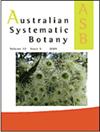Using RADseq to resolve species boundaries in a morphologically complex group of yellow-flowered shrubs (Geleznowia, Rutaceae)
IF 1.6
3区 生物学
Q4 EVOLUTIONARY BIOLOGY
引用次数: 1
Abstract
ABSTRACT The morphologically complex and charismatic genus Geleznowia (Rutaceae) is endemic to south-western Australia and faces existing and potential conservation issues associated with land clearing, climate change and commercial harvesting. Two species are currently recognised in the genus, but horticulturally recognised forms and phrase-named taxa reflect additional suspected species diversity. The genus exhibits complicated and subtle patterns of morphological variation that have historically inhibited delimitation of taxonomic entities and, as a result, precluded effective conservation assessments. Here we used ddRAD data from 25 populations across the range of Geleznowia to elucidate genomic diversity in the group in conjunction with morphological re-assessment so as to delimit species and revise the taxonomy. Our analyses consistently identified seven entities that maintain genomic distinctiveness even in sympatry with other entities, supporting the inference of reproductive barriers and lineage divergence. Morphological assessment of more than 300 specimens corroborated these seven taxa. Consequently, we recognise seven species of Geleznowia in Western Australia, retaining G. amabilis K.A.Sheph. & A.D.Crawford, recircumscribing G. verrucosa Turcz., reinstating G. calycina (J.Drumm. ex Harv.) Benth., and naming four new species as G. eximia K.A.Sheph. & A.D.Crawford, G. narcissoides K.A.Sheph. & A.D.Crawford, G. occulta K.A.Sheph. & A.D.Crawford, and G. uberiflora K.A.Sheph. & A.D.Crawford.利用RADseq解析形态复杂的黄花灌木类群(黄花灌木科)的种界
摘要形态复杂、魅力非凡的芸香属(芸香科)是澳大利亚西南部的特有植物,面临着与土地清理、气候变化和商业收割相关的现有和潜在的保护问题。该属目前有两个物种,但园艺上公认的形式和短语命名的分类群反映了额外的可疑物种多样性。该属表现出复杂而微妙的形态变异模式,这在历史上阻碍了分类实体的划界,因此阻碍了有效的保护评估。在这里,我们使用了来自Geleznowia范围内25个种群的ddRAD数据,结合形态学重新评估来阐明该群体的基因组多样性,以界定物种并修改分类学。我们的分析一致地确定了七个实体,即使在与其他实体的同域中也保持着基因组的独特性,支持了生殖障碍和谱系分化的推断。对300多个标本的形态学评估证实了这七个分类群。因此,我们在西澳大利亚确认了七种Geleznowia,保留了G.amabilis K.A.Sheph.和A.D.Crawford,重新标记了G.verrucosa Turcz。,恢复G.calycina(J.Drumm.ex Harv.)Benth。,并命名四个新种,分别为C.eximia K.A.Sheph.&A.D.Crawford、G.nasoides K.A.Sheph.&A.D.Crawford,G.occluta K.A.Shep.&A.D.Clawford和G.uberiflora K.A.Shepp.&A.D.克劳福德。
本文章由计算机程序翻译,如有差异,请以英文原文为准。
求助全文
约1分钟内获得全文
求助全文
来源期刊

Australian Systematic Botany
生物-进化生物学
CiteScore
3.10
自引率
12.50%
发文量
12
审稿时长
>12 weeks
期刊介绍:
Australian Systematic Botany is an international journal devoted to the systematics, taxonomy, and related aspects of biogeography and evolution of all algae, fungi and plants, including fossils. Descriptive taxonomic papers should normally constitute a comprehensive treatment of a group. Short papers on individual species and nomenclatural papers must contain significant new information of broader interest to be considered. The prestigious L.A.S. Johnson Review Series is published. Other review articles will also be considered. All papers are peer reviewed.
Australian Systematic Botany is published with the endorsement of the Commonwealth Scientific and Industrial Research Organisation (CSIRO) and the Australian Academy of Science.
 求助内容:
求助内容: 应助结果提醒方式:
应助结果提醒方式:


